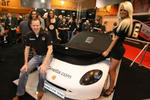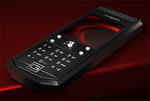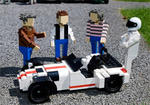
Ricardo and Force Protection Europe have unveiled today the Ocelot LPPV which they say represents the next-generation in defense vehicle performance and crew protection. The Ocelot LPPV is 5.3m long and 2.1 wide and it has a turning circle of 12 meters thanks to its four wheel steering. The power of the Ocelot LPPV comes from Steyr 3.2 liter straight six diesel engine mated to a 6-speed ZF gearbox and AxelTech differentials. The power and performance figures of the Ocelot LPPV have not been announced.
The engine, gearbox, fuel tank and suspension of the Ocelot LPPV are all hidden inside the V-shaped hull of the car that acts like an armor.
Ricardo Press Release:
Team Ocelot – a unique collaboration between Ricardo and Force Protection Europe – has today launched a revolutionary new light protected patrol vehicle (LPPV) concept offering the potential for much higher standards of occupant protection and operational flexibility than today’s defense light vehicle products
The new Ocelot LPPV vehicle was unveiled at the Defence Systems & Equipment International Exhibition, the world’s largest fully integrated international defense exhibition, at London’s ExCel arena. Starting from a completely clean sheet design, Ocelot brings together some of the very latest innovations in automotive and defence technologies to deliver a highly practical vehicle designed for deployment in the most demanding and hostile of operational environments. Based on a modular design, Ocelot comprises a core automotive armoured spine or “skateboard” onto which one of a number of alternative special to role “pods” is mounted.
These roles include a patrol, fire support or protected logistics vehicle and the pods are easily interchangeable in the field as the need requires. The V-shaped hull configuration formed by the combination of skateboard and pod, coupled with the use of the latest in advanced composite technology, provides a practical vehicle package with exceptional manoeuvrability, operational flexibility, and unparalleled levels of occupant protection for a vehicle of its class. Moreover the protection provided by the skateboard spine to its internal automotive systems, provides a much higher level of operational robustness.
Commenting on the launch of Ocelot, David Hind, MD of Force Protection Europe Ltd, said:
“By designing from a clean sheet we have adopted a novel design which is a complete departure from the standard practice of basing mine resistant vehicles on a standard chassis design. We are confident that the V-shape design of Ocelot means it not only meets today’s blast resistance requirements but those expected in the future.”
Dave Shemmans, CEO of Ricardo plc, added:
“We are extremely pleased to have been able to work with Force Protection Europe to create this exciting new vehicle concept. Ocelot offers a highly practical defence vehicle solution to
current and future operational requirements, while also providing unparalleled levels of occupant safety against the very real and present threats of a hostile theatre environment. This is just another example of how Ricardo is able to work with its partners and customers to deliver the very latest in automotive innovation and technology in truly exceptional defence vehicle solutions.”
The Ocelot is the result of a unique collaboration drawing together the defence vehicle skills and technology of Ricardo and Force Protection Europe. The combination of a skateboard design and pod chosen for this vehicle aims to give increased survivability against blast and mines. The core of the design is a V-shaped hull or skateboard that houses the Steyr 3.2 litre straight six diesel powerpack, propshaft, 6-speed ZF gearbox, AxelTech differentials, fuel tank and all the suspension gear except a torsion bar which is mounted alongside the hull. In the event of an attack the vehicle is able to keep moving even if it has lost a wheel as the rest of the automotive parts are protected.
The composite pod has been designed to be interchangeable, and in the patrol vehicle there is seating for two crew and four dismounts. Access to the vehicle is through large rear doors, two top hatches or if required an oversize commander’s door. The V-shape design results in the running gear not intruding into the crew area making movement from front to back easy and also reducing the threat to the occupants from the running gear in the event of an attack. Bulkheads between vehicle crew and dismounts and between them and the vehicle electronic equipment such as radios and electronic counter measures give added protection.
The pod fits onto the skateboard and has a novel tilting mechanism not previously seen in an armoured vehicle. The pod is attached to the hull by hinges which are kept in place with pins. To carryout maintenance the wiring loom from the pod is disconnected from the skateboard together with the steering connection and the crew pod is then tilted using an another vehicle and strops to pull it over, full access is then available to all the automotive parts. To change the pod the pins are removed from the pod and the skateboard driven to a new pod and this is then connected and tilted back onto the vehicle.
As part of the design of the vehicle maintenance was a high priority and integral to the overall concept enabling major assemblies to be rapidly changed in the field rather than having to recover the vehicle to a base workshop to carry out repairs. For example a new powerpack can be flown into a forward operating base and changed over in less than one hour.
Ocelot is a 71/2 tonne vehicle which can be transported in a C-130 or underslung on a Chinook. It has four wheel steering giving it a market leading turning circle of 12 metres and has a low centre of gravity as all the heavy items are contained within the skateboard. It is 5.3m long, 2.3 high and 2.1 wide.












